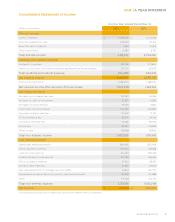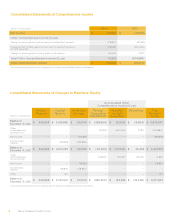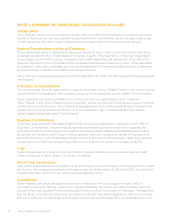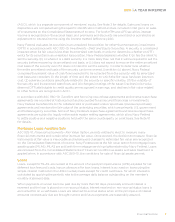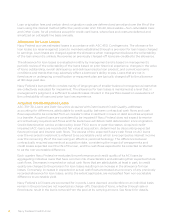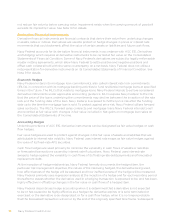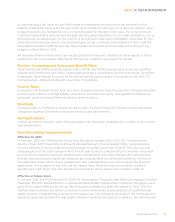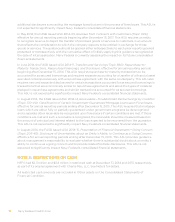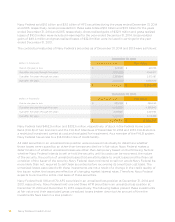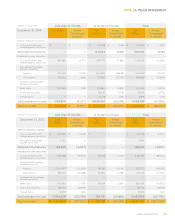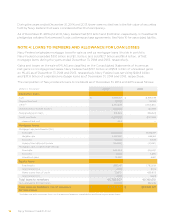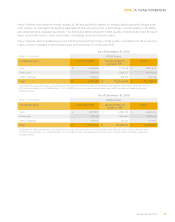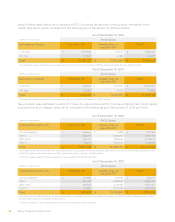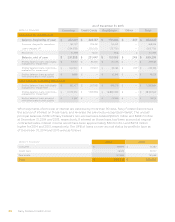Navy Federal Credit Union 2014 Annual Report Download - page 28
Download and view the complete annual report
Please find page 28 of the 2014 Navy Federal Credit Union annual report below. You can navigate through the pages in the report by either clicking on the pages listed below, or by using the keyword search tool below to find specific information within the annual report.Navy Federal Credit Union10
not reduce fair value to below carrying value. Impairment exists when the carrying amount of goodwill
exceeds its implied fair value. See Note 14 for details.
Derivative Financial Instruments
Derivative financial instruments are financial contracts that derive their value from underlying changes
in assets, rates or indices. Derivatives are used to protect or hedge changes in prices or interest rate
movements that could adversely aect the value of certain assets or liabilities and future cash flows.
Navy Federal accounts for its derivative financial instruments in accordance with ASC 815, Derivatives
and Hedging, which requires all derivative instruments to be carried at fair value on the Consolidated
Statements of Financial Condition. Some of Navy Federal’s derivatives are subject to legally enforceable
master netting agreements, which allow Navy Federal to settle positive and negative positions and
oset cash collateral held with the same counterparty on a net basis. Navy Federal does not utilize a
net presentation for derivative instruments on its Consolidated Statements of Financial Condition. See
Note 9 for details.
Economic Hedges
Navy Federal enters into mortgage loan commitments, also called interest rate lock commitments
(IRLCs), in connection with its mortgage banking activities to fund residential mortgage loans at specified
times in the future. The IRLCs that relate to mortgage loans Navy Federal intends to sell are considered
derivative instruments under applicable accounting guidance. IRLCs expose Navy Federal to the risk
that the price of the loans underlying the commitments may decline between the inception of the rate
lock and the funding date of the loan. Navy Federal is exposed to further price risk after the funding
date up to the time the mortgage loan is sold. To protect against price risk, Navy Federal utilizes forward
sales contracts. The IRLCs, forward sales contracts and mortgage loans Navy Federal intends to sell
are recorded at fair value with changes in fair value included in Net gains on mortgage loan sales on
the Consolidated Statements of Income.
Accounting Hedges
Under the provisions of ASC 815, derivative instruments can be designated as fair value hedges or cash
flow hedges.
Fair value hedges are used to protect against changes in the fair value of assets and liabilities that are
attributable to interest rate volatility. Navy Federal uses interest rate swaps as fair value hedges against
the value of its fixed-rate AFS securities.
Cash flow hedges are used primarily to minimize the variability in cash flows of assets or liabilities
or forecasted transactions caused by interest rate fluctuations. Navy Federal uses interest rate
swaps to hedge against the variability in cash flows of its floating-rate debt payments and forecasted
replacement debt.
At the inception of hedge relationships, Navy Federal formally documents the hedged item, the
particular risk management objective, the nature of the risk being hedged, the derivative being used,
how eectiveness of the hedge will be assessed and how ineectiveness of the hedge will be measured.
Navy Federal primarily uses regression analysis at the inception of a hedge and for each reporting period
thereafter to assess whether the derivative used in a hedging transaction is expected to be, and has been,
highly eective in osetting changes in the fair value or cash flows of a hedged item.
Navy Federal discontinues hedge accounting when it is determined that a derivative is not expected
to be or has ceased to be highly eective as a hedge; the derivative expires or is sold, terminated or
exercised; or the derivative is de-designated; or for a cash flow hedge, when it is no longer probable
that the forecasted transaction will occur by the end of the originally specified time frame. Subsequent





